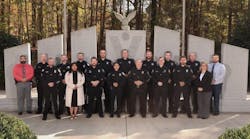Time plus distance equals the formula school bus drivers are taught should they come upon a truck leaking hazardous materials. It is the school bus driver's job above all to keep the vehicle's precious cargo safe. That means getting the bus uphill, upwind and away from the hazard as quickly as possible.
Law enforcement officers lack this luxury.
There to "protect and serve," these guardians of justice must drive their vehicles into the mix and brace whatever chemical hazards they find. They must remain on site until they safely evacuate the area and hazmat teams finish cleaning up the spill.
But in a toxic materials release, the chemicals are most hazardous when they are discharged into the air, onto the ground or into a nearby water stream.
While responding officers assess the nature and extent of the spill, call for back up, establish incident boundaries, and begin traffic and crowd control procedures, they also must protect themselves from toxins in the air and on the ground. It's critical those on the frontline safeguard their own health and safety as well as that of any civilians in the area.
Community vulnerabilities
There were more than 13,000 transportation-related hazmat accidents in 2006 - 85 percent of which occurred on the nation's highways or railways. However, there are many other places an officer might encounter a hazmat event and potentially be exposed
to a toxic chemical.
In June 2005, a fire started at a compressed gas company in a St. Louis, Missouri, suburb. The resulting explosions sent large compressed gas cylinders more than 100 feet into the air, releasing sizeable amounts of burning gases. Neighborhoods were evacuated and roads closed including an interstate highway at the height of the blaze. In another case in November 2006, a small solvent and ink manufacturing plant in a quiet residential neighborhood in Danvers, Massachusetts, erupted in an explosion that witnesses likened to a 2,000-pound bomb. Police and firefighters were faced with a raging fire of unknown origin and the potential for toxic chemical release. The fire was elevated to 6+ alarms before being brought under control. In the end more than 90 homes and buildings in the area were damaged, a number of individuals injured and the entire plant destroyed.
For this reason, protecting officers and the community at large, in a hazmat situation, begins with surveying these types of businesses and other vulnerable areas before an incident occurs.
Many companies produce or use chemicals in the course of doing business. Gas stations, printing companies, hardware stores, oil storage and distributors, compressed gas companies, small specialty chemical manufacturers, etc. all present the potential for a hazardous event that law enforcement may be called to.
Highways and railways running through a community must be considered as well. While an overturned truck is a relatively small incident, a derailed train presents a much larger hazmat problem. Tanker cars on trains routinely haul toxic chemicals such as chlorine, anhydrous ammonia, aniline, cyclohexane and butyl acetate. When these tankers crash, they emit a cloud of toxic gas into the environment. Police are then charged with overseeing the evacuation of people in the area. In that process the officer must constantly observe his surroundings to ensure he does not get trapped in the advancing toxic cloud that can suddenly change direction due to wind shifts or subsequent explosions.
In a full-blown hazmat incident, the site is divided into three zones: hot, warm or cold. Officers may enter the cold zone but must have appropriate protective gear and training to enter warm or hot zones. It is imperative officers fully understand the procedures involved in establishing an incident command center, designating an incident commander and following chain of command.
The clandestine drug lab presents another hazmat situation officers may face. The illegal meth lab may be the most toxic and dangerous environment an officer encounters in all his years of service. Drug traffickers derive meth from commonly available chemicals and solvents. These lab operators are often individuals with little regard for safety - either their own or that of the neighborhood around them. More than 25 percent of all illegal drug labs are discovered because they catch on fire or simply erupt in a violent explosion. (A list of common chemicals used in meth labs can be found at www.doh.wa.gov/ehp/ts/CDL/methhazards.htm.)
Besides the ever-present danger of armed lab operators willing to do anything to protect their operation, officers may be exposed to or overcome by toxic fumes or be inside a structure when the lab explodes. In the final stages of meth production, the so-called "cook" operation, the likelihood of explosion is so great that in most cases the lab operators actually leave themselves.
HAZWOPER rules
To heighten officer and community safety, it is critical that all police officers possess a basic understanding and awareness of what they may encounter during a hazardous materials incident. They need to be familiar with hazardous materials placards and their meanings to quickly assess potential dangers on-scene. Training should also instruct officers in establishing an incident command center and determining an incident command authority. Regulations and hazmat operations set ups vary from state to state making it critical that training be geared to each state's specific requirements.
The federal Occupational Safety and Health Agency (OSHA) has established training levels for individuals responding to hazardous materials incidents under the HAZWOPER rule (see CFR1910.120). This document mandates all law enforcement officials be trained at the Awareness level (Level 1) which trains an officer to:
- recognize the presence of hazardous materials at an incident scene;
- know how to survey the incident scene from a safe location and identify the potential hazardous materials present by name, materials placard type, ID number or from MSDS sheets;
- recognize the signs of a terrorist attack if chemical, biological or radioactive materials are suspected;
- notify appropriate responders and provide as much detail as possible; and
- initiate protective actions to ensure the safety or evacuation of persons in the area.
Level 1 training, which typically involves a 4- or 8-hour course, should include a combination of classroom, video training and actual hands-on incident simulations and cover both fixed-facility and transportation-related incidents. The training also must introduce officers to the types of protective equipment used at a hazmat site and cover fit testing of full-face respirators.
Level 1 training courses are offered by a number of training companies and in most states either through the state police, state fire marshal's office, or local police or fire departments.
OSHA mandates law enforcement officers expected to respond to hazmat incidents at the Operational Level (Level 2) take an additional 24-hour (three-day) course in how to contain a hazardous release and effectively evacuate an area. In addition officers learn how to select and use the appropriate personal protective equipment (PPE) including full-face respirators and self contained breathing apparatus (SCBA). This training also covers decontamination procedures.
Officers receiving either Level 1 or Level 2 training should also take an appropriate refresher course each year. A variety of private training companies, some universities and larger metropolitan departments, as well as state police departments, provide training opportunities geared to field officers' needs. Hands-on field simulations with these other public safety organizations are a must for adequate training. By taking this training alongside firefighter and EMS personnel, officers learn to understand the problems and concerns of all public safety entities involved in a hazardous situation.
Driving away is not an option for law enforcement professionals in hazmat situations. To keep themselves and the public safe, however, officers need the wherewithal to stay. This comes through adequate training and preparation well before an incident occurs.


